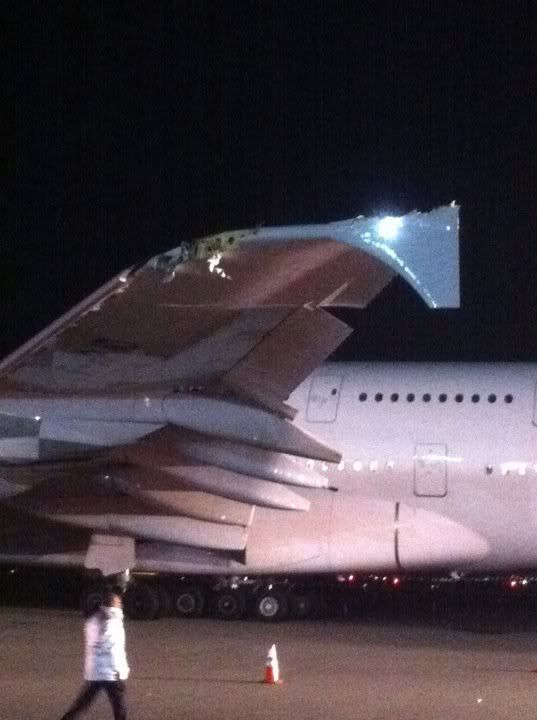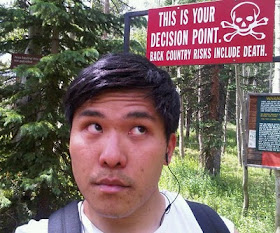I got a whole whack of information in this post from AvCanada, specifically the accident speculation thread. Stuff in quotes is taken verbatim from the discussion thread.
This is the ILS approach chart for Runway 35T into Resolute Bay. Do NOT use this to navigate, it's out-of-date now.

This is what the ILS into Resolute Bay looks like. The ceiling in this approach was 1,300':
On August 20th 2011, First Air flight 6560 was a 737 travelling from Yellowknife to Resolute Bay with 15 people on board, including four crew members. They called about 4 miles final for the runway, and then crashed a few minutes later. The aircraft appears to have been under control, and the surviving passengers reported nothing unusual right up to the point of impact.
The accident report hasn't come out yet, and the following stuff is entirely speculation - I want to make that clear. But I'm going to speculate.
METAR CYRB 202000Z 18009KT 8SM VCFG SCT003 OVC005 07/07 A2986 RMK
SF2SC5 VIS E-SE 3 FG SLP116=
The weather at the time of the accident was foggy with low (300') scattered and (500') overcast layers. People on the ground couldn't see much at all, but flight visibility can be very different from ground visibility.
We do know some things: The crew was still in control on three mile final, the engines were running, the aircraft is oriented parallel to the runway and level with the horizon, and the wreckage is strewn across a large area. If it had stalled or a mechanical failure had caused it to rapidly descend it would leave a much smaller impact area. That has all the hallmarks of classic CFIT, or 'controlled flight into terrain'.

Here's a Google earth view of the area around the accident. The wreckage trail is represented by the yellow line. The gully leading down from the nose of the aircraft at the end of the wreckage appears to contain the same washed out sort of area in google and the photo. The two red circles outline similar geometric forms. One is the approach end of 35T. The other is a road structure on a slightly sloping flat area elevated above the airport by about 325 feet and one mile to the right of the centerline of the runway. The lake to the southeast of the wreckage trail could appear in certain cloud arrangements to be similar to the shoreline on the approach to 35T.
The aircraft would have been between two layers of clouds with approximately 200 feet between layers, with the bottom scattered layer at 475 ASL and the top broken layer at 675 ASL. Some of what was a scattered layer from the weather observation point may have been broken in the hill above.
Now here's the thing: Even with the local terrain being a bit confusing, there should have been no problem finding the runway and landing with any normal kind of ILS approach, with a 500 foot ceiling. ILS tolerances are pretty tight, and it would be really hard to conceive why the aircraft would have been a mile to the right of its course, and more or less on runway heading without any abnormal indications to the crew.
Let's add some more information: here's another picture of the accident site, this time with the Resolute VOR location plotted. This one chills my bones.

It turns out the ILS was functional on that day, but suppose the crew didn't get a glideslope indication and decided to fly the Localizer only approach. That takes them down to 540' ASL. The ridge they hit was 653' ASL.
The step down approach (localizer) really comes into the equation if the aircraft is mistakenly inbound on the 167T radial from YRB. In that scenario, the crew believes it is tuned to the ILS, can't get glideslope, and switches to a localizer approach with the final drop only 160 feet four miles back. They keep tracking the 167T radial as if it were the localizer. They don't have glideslope because they're tuned to 112.1 instead of 110.3. Their DME is coming off the VOR.
"In the mistuned VOR scenario, they have to have POKAN on the 167 radial at 4 DME, a mile east of proper track. Then do the procedure turn and fly back inbound on the false localizer. Maybe they left the VOR eastbound with 167 already set on the OBS, flew it needle centered to the false POKAN, did the PT and re-intercepted inbound. Get no GS, maybe call it in U/S, and fly the localizer approach instead. That scenario ends exactly where the accident happened.
I can't see a late tuning of the VOR and nobody noticing that the needle moved when the OBS was turned. If they'd been tracking 167 outbound to Pokan, and then set up the inbound course on the CDI, they wouldn't have noticed it so much as they would have been in the PT where they would expect it to be deflected."
An added factor now: Has anyone noticed that there is no missed approach point for the LOC/DME approach on the ILS/DME 35T plate? Not on the DND copies anyway. Take a look.
A second factor: Notice how the VOR isn't even depicted on the ILS chart? Why on earth would the crew have it tuned in? Well, a couple of possibilities exist. There was a temporary military control tower at Resolute that day, coordinating aircraft that were participating in a mock search-and-rescue exercise. The control tower was asking other aircraft for their radial and distance to the airport, and the accident aircraft had reported that information to the control tower fairly late in their approach. In order to report that information they would have had to tune in the VOR. The other possibility is that maybe they were using the VOR to navigate to the airport before commencing the approach.
"Another Canadian carrier used to have an unofficial procedure on the 737-200. If you wanted to retain the DME display while doing an ILS, you would tune #1 to the ILS and #2 to the VOR. Then you would transfer the display [overhead switch] to "both on 1" Now, both pilots would have their HSI displaying the info from the #1 radio, and the dme would readout from the vor still tuned on the #2 radio. This practice was banned after a crew mistakenly switched "both on 2" during an approach to Prince George. Thinking they were tracking the LOC, the aircraft descended towards the YXS VOR and very nearly had an accident. [With both radios tuned to the ILS you would not have a DME readout and there is no DME hold switch on the 200] The practice of transferring the display was then banned and to be used only in case of radio failure. Keep in mind that was another air carrier, not First Air."
Here's a pic of the panel from the actual accident aircraft.

Hmm, same switches.
But wouldn't their GPWS (Ground Proximity Warning System) have saved them? The 737 in question was equipped with an older model, which basically gives no warnings once the landing gear is down. GPWS will only give you two calls "500'" and "Sink Rate", whereas the newer Enhanced GPWS will give 1000', 500' 100', 50', 40', 30', 20', and 10' above ground calls. This late in the approach, the gear would have been down.
So here's my speculation: With the knowledge that the military was asking for radials/DME bearings prior to the crash, maybe the VOR was tuned in, thinking they had the ILS frequency up. Now to those of you who fly IFR, how often have you made a late change in the approach? It happens to me once in a while. If you thought you had the ILS tuned in and once on the approach you had a G/S flag, it would be a fast and easy brief to re-brief for the LOC only approach and continue to the higher minumums (especially in an environment such as the Arctic airports)...if that was the case here, the LOC only minimums still would have put them into a hill if they were tracking the VOR.
One final pic:

This was taken on the LOC DME BC approach to rwy 17T (the accident runway, just landing in the opposite direction) in 2009. The distance to the rwy threshold is less than 1.5NM. Can you spot the runway? Imagine looking for that in low cloud and fog, let alone adding being on the wrong approach frequency.
Lots of links in the accident chain on this one, and again the final report hasn't come out yet - but if it went even remotely close to how I think it went, you can see the tragedy that resulted from a bunch of different factors that added up all at once.





























